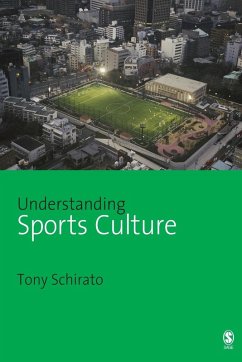"In only 138 pages Schirato manages a broad sweep across sports history and culture... he brings the eye of a critical fan to his analysis of sport, treating it seriously as a social practice and as a social institution... A useful, provocative and non-dogmatic text that should be useful to undergraduate and graduate sport studies programmes."
- Malcolm MacLean, Sport in History
Understanding Sport Culture traces and analyzes the development of the modern field of sport from its ancient and medieval precursors (the festivals of Greece and Rome, and games such as folk football), through to its inception in the mid-nineteenth century as a set of activities designed to instill character and discipline in students in exclusive British public schools, up to its transformation into a global institution and popular spectacle.
The narrative also focuses on and provides a detailed account of the gradual coming together of sport and the media. It explains how this relationship has accentuated sport's status as one of the most important sites in contemporary culture, while simultaneously threatening its existence.
As part of the Understanding Contemporary Culture series this book is aimed at a broad range of students from undergraduate to graduate level, who want to know more and be fully informed on sport, its relationship to the media, and its cultural dynamics.
- Malcolm MacLean, Sport in History
Understanding Sport Culture traces and analyzes the development of the modern field of sport from its ancient and medieval precursors (the festivals of Greece and Rome, and games such as folk football), through to its inception in the mid-nineteenth century as a set of activities designed to instill character and discipline in students in exclusive British public schools, up to its transformation into a global institution and popular spectacle.
The narrative also focuses on and provides a detailed account of the gradual coming together of sport and the media. It explains how this relationship has accentuated sport's status as one of the most important sites in contemporary culture, while simultaneously threatening its existence.
As part of the Understanding Contemporary Culture series this book is aimed at a broad range of students from undergraduate to graduate level, who want to know more and be fully informed on sport, its relationship to the media, and its cultural dynamics.
A particular strength of Understanding Sports Culture is the author's ability to meet the claim for breadth of student readership. The book is clearly structured, flagging from the outset a journey from ancient sporting times and the assumed human need of play to the development of modern and ultimately global and highly commercialized sporting cultures. His theoretical interruptions of the historical narrative are not only pertinent but elucidating, and pitched in a way that is accessible to undergraduate students... [S]port studies has not always benefited from the intrusion of scholars from the cultural studies and media studies mainstream. One problem has been that cultural studies scholars do not generally know as much about sport as scholars who have devoted their careers to studying that area of human acticvity. The more insulting problem is that there tends to be little awareness of the existing dedicated scholarship on sport. No such ignorance is apparent in Understanding Sports Culture. Indeed, the strength of this book is its fruitful blending of key scholarship on sport with theoretical work from cultural studies and the sociology of culture
John Hughson
European Journal of Cultural Studies
In only 138 pages of text he manages a broad sweep across sports history and culture... Schirato brings the eye of a critical fan to his analysis of sport - he treats it seriously as a social practice and as a social institution... [He] achieves his aims by providing a useful, provocative and non-dogmatic text that should be useful to undergraduate and graduate sport studies programmes
Malcolm MacLean
Sport in History
John Hughson
European Journal of Cultural Studies
In only 138 pages of text he manages a broad sweep across sports history and culture... Schirato brings the eye of a critical fan to his analysis of sport - he treats it seriously as a social practice and as a social institution... [He] achieves his aims by providing a useful, provocative and non-dogmatic text that should be useful to undergraduate and graduate sport studies programmes
Malcolm MacLean
Sport in History

